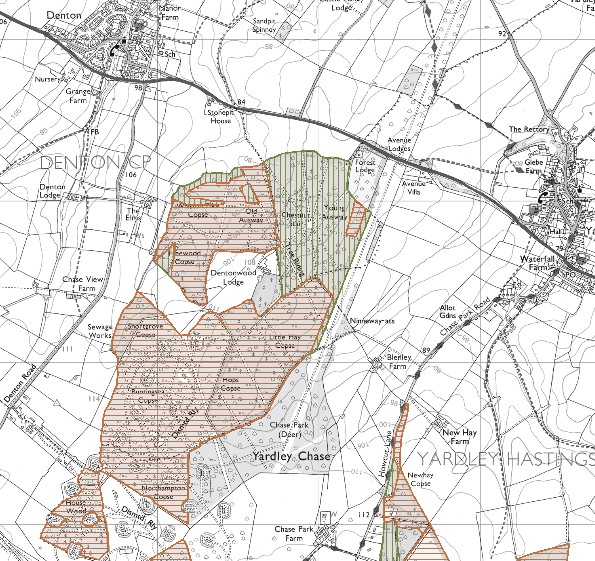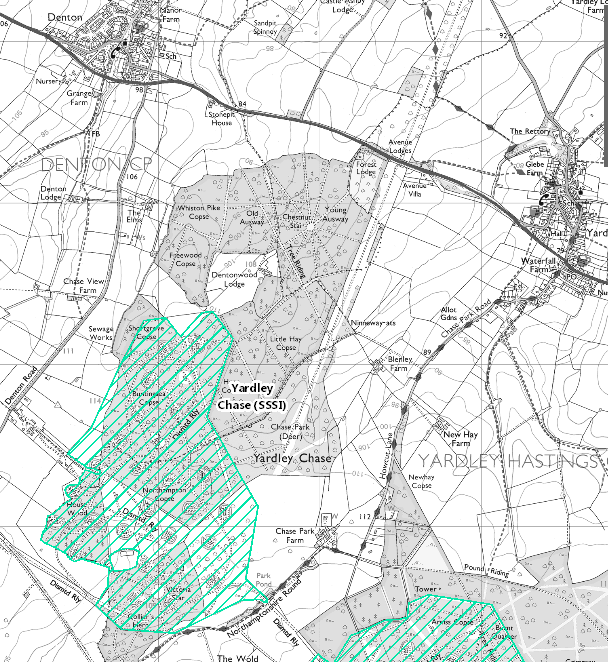
I bet you don’t know much about Denton Wood do you? Neither did I until very recently even though it’s only about 20 minutes drive from my house.
It’s an area of Ancient Woodland which has, like many in this area, conifers planted in it in the past, but many such woods are recovering as the conifers are removed.

And Denton Wood is contiguous with the Ancient Woodland of Yardley Chase SSSI:

I gather that the Forestry Commission has been felling trees in this area in the last few weeks – clearly in the birds’ nesting season and also that they have not followed their own guidelines on Great Crested Newts (that’ll be Guidance on managing woodlands with great crested newts in England). That might mean that they have broken the law. It’s a large area of felling: about 30% of the wood is being affected and felling is continuing.
The person who has been stirring things up about the Forestry Commission behaviour in this area is Jeff Blincow of the Yardley Chase management group. He has not got very far with either the FC or the Police.
Denton Wood is a secluded wood with no public access (I’ve never been in there myself) so it is the type of place where one might try to get away with cutting corners without too much chance of people noticing – if that is what has happened here.
 Local opinion is that the felling operations, which might well be beneficial to the site in the long run, are being carried out at this time of year so that they do not interfere with Pheasant rearing and shooting later in the year.
Local opinion is that the felling operations, which might well be beneficial to the site in the long run, are being carried out at this time of year so that they do not interfere with Pheasant rearing and shooting later in the year.
RSPB, the Beds, Cambs and Northants Wildlife Trust, the Forestry Commission and the local Police have all been informed of what is happening.
This wood is in the South Northamptonshire constituency whose Conservative candidate in the general election is the Secretary of State for the Environment, Andrea Leadsom.
More on this as things develop.
Note added later: this blog was written and scheduled yesterday evening. I heard the tragic news from London after this blog was posted and it would have been difficult to delete as I was out counting birds on my BBS square. However, I’ll delay posting comments on here (there are a couple already) until this evening.
[registration_form]
Our now retired and not really replaced WCO was of the opinion that felling in the breeding season without checking every tree and shrub effected for nests thoroughly before hand is reckless disregard for the Wildlife and Countryside Act and got it stopped locally in Railtrack property under threat of prosecution.
No public access? Are those bomb storage bunkers at the south end?
Circus – I believe they may have been, and are on MOD land which, I am told, is well-managed for wildlife.
To clarify there is still a cadet training facility along Denton Wood. Often park my truck along that Denton Road and often here and see Cuckoo, Redkite, Buzzard. At the entrance on the A428 there is a small sign saying tree felling is taking place too.
I never knew the wood was FC either and assumed it was owned by the Compton Estate (Castle Ashby) and managed by the FC. Probably wrong though.
don’t see why you shouldn’t post a thing like this just because of a terrorist attack
M parry – thanks
The Forestry Commission locally conduct extensive fellings in the spring, our own estate is little better,although a small wood has gained a temporary reprieve due to a Buzzard nest.
Looks like the FC are decidedly at fault – ignoring both their own operating requirements and the law in rather reckless fashion.
If raising the issue at the local level isn’t working it seems there is a need for immediate consultation at the highest level. No, not Andrea (as if!).
What do Stick Man and the Gruffalo (and all their fans and marketing teams) think? Are they happy with situation? What might be done to prevent recurrence?
Stick Man safe in the family tree
With his Stick Lady Love and their stick children three.
One day wakes early, there’s a noise in the air.
Stick Man, oh Stick Man, beware, oh beware!
[Intro to Stickman II: Dell razer]
Presumebly Natural England has been informed too? If its in the SSSI then its likely to be an offence under the WCA.
They [NE] may well have consented the works?
Conversely it would be nice to learn that the guardians of wildlife would / have stepped in?
Experience here sees them as apologists for others as well as culprits of management works in the breeding season. Pregnant adders have also been mangled as the price of keeping those paths nicely manicured for the public open access. Statute and business above accepted regulations by which others must adhere?
Interesting that it’s in the SoS backyard, do please keep us informed. Has anyone invited her to the site or to provide comment I wonder?
Denton Wood: surely a job for Inspector Frost?
Unfortunately, it’s not unusual to see wildlife NG0s conducting management operations during the breeding season. I have frequently come across teams of volunteers clearing scrub and strimming dense vegetation in May and June when many nests will be hidden in such locations. Added to which the monitoring of selected species is often conducted with complete disregard for the law relating to schedule1 birds which may be nesting in close proximity. I think it’s time for conservation organisations to put their own houses in order on these issues and stop behaving as if the rules don’t apply to them. Lead by example should be the rule.
Terrible, isn’t it ? – or is it ? Denton Wood is part of the restoration of ancient woodland in the East Midlands. It is the latest part of a 15 year programme of conifer felling that has continued throughout the year in wood after wood. These same woods that are now being put forward as SSSIs – as Denton Wood will almost certainly be within the next five years. The programme is enormous, covering 5,000 hectares (12,000 acres) and is on the same scale as the largest national lowland programmes such as heathland restoration.The link to FC guidelines explains why felling is year round. Like many others, my heart tells me that we shouldn’t fell in the breeding season – but my head sees the hard conservation science – in the ranking of reasons for decline of woodland bird populations lack of management is first. Disturbance from harvesting doesn’t feature at all – assuming a 50 year rotation, only 1/150th of the forest is affected during the breeding season.
From the information given this wood is probably leasehold with the shooting retained and avoiding disturbance of pheasants could well be a reason for felling in the summer – but the presence of Great Crested Newt suggests another possibility – the reason many of these ancient woods survived is because they are on incredibly heavy, wet clay and removing trees without doing spectacular ground damage can be close to impossible – on balance, working in the driest months may minimise the overall environmental impact.
Current law is confused: amalgamating English law and European law has been messy and a Law Commission project set out to try and resolve some of the issues – but has not been taken forward by Defra. There are obviously contentious issues – like the legal status of released game birds. But a key problem is protection of the individual (favoured by English law) versus population (favoured by European law). An extreme example of this is the ‘Dormouse conundrum’. Whatever time of year you manage dormouse habitat you are liable to harm dormice – destroying nests in summer, squashing hibernating dormice in winter. But if you do nothing at all you will reliably exterminate dormice completely as the wood gets darker and darker – and that is happening right now, all over lowland England. As the legislation stands it is hard to guarantee that someone won’t try and prosecute you if you fell trees in dormouse habitat – though they are unlikely to succeed. That is probably discouraging smaller conservation bodies like Wildlife Trusts from managing. It is probable that legislation to protect dormice is currently one of the biggest threats to the species.
What this suggests to me then is that there has been a break down in communication? OK, no public access but does anyone seriously think folk don’t spot these kinds of things?
There must have been the opportunity to explain to the public the long term plans if what Roderick says is the case, likewise contacting the local WT?
Never easy or black and white?
Long ago, as a reserves manager for a WT, I evolved a rule of thumb that seems to be a universal truth. If you repeat the “ideal” management for any species year after year you guarantee its eventual extinction on the site.
Example; a chalk grassland. You can’t graze it in spring or summer because of the butterflies and chalk grassland flowers. But by late summer the grass is straw, rank and largely inedible even for tough old hill sheep, and the young shoots from the scrub are only edible in spring anyway. So the grass grows ranker and ranker and the scrub spreads.
These sites never had a set regime before. They’d be felled when the village (or navy) needed wood, grazed harder or coppiced more often when the cottager had a daughter to wed, and less hard when they were old or ill and wanted an easier life. Nothing about a fixed regime is either historical or “natural”.
Sometimes a conservationist has the responsibility to see the bigger picture that a species specialist naturalist does not.
Nimby – a very fair point – and I’d agree a bit of a surprise. Recognising the scale and importance of change Fc ran a massive consultation & publicity campaign – I have a copy of issue 4 of Ancinet Woodland – the project magazine, from 2003, in front of me – and interestingly it features an article on Dormouse where FC is working with English Nature & The peoples Trust for Endangered species.
I can only imagine that partly because this wood is not well known and partly because shooting leaseholders can be very sensitive about anything that might suggest public access less consultation went on here – but that is for Fc to answer. However, it certainly won’t have been an attempt to hide what was going on – as several commenters have pointed out trying to hide large scale tree felling is a bit of a waste of time !
Well said Roderick. Thinning and felling trees has been done by the Fc and other organisation since 1919 and all year round and no doubt will continue to do so, if not we will end up with dark dank forests with very little wildlife in , With birds and animals being protected by laws in place, of which these organisations know they need to abide to and are under strict restrictions under UKWAS to do so.
Specialists again only seeing what they want to see and not the whole picture!!